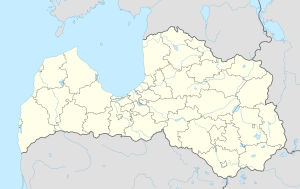Seda () is a town in Valmiera Municipality in the Vidzeme region of Latvia. It is founded in 1952. The major local industry is extraction of peat. The town is remarkable for its 1950s-style Stalinist architecture, dating from the glory days of Seda, when workers from all over the Soviet Union came to work for the peat extraction enterprise.
Seda | |
|---|---|
Town | |
| Coordinates: 57°38′N 25°45′E / 57.633°N 25.750°E | |
| Country | |
| Municipality | Valmiera Municipality |
| Town rights | 1991 |
| Area | |
• Total | 2.02 km2 (0.78 sq mi) |
| • Land | 1.99 km2 (0.77 sq mi) |
| • Water | 0.03 km2 (0.01 sq mi) |
| Population (2024)[2] | |
• Total | 1,092 |
| • Density | 540/km2 (1,400/sq mi) |
| Time zone | UTC+2 (EET) |
| • Summer (DST) | UTC+3 (EEST) |
| Postal code | LV-4728 |
| Calling code | +371 647 |
| Website | http://www.valka.lv/?id=96 |
Joint stock company "Seda" is still a major employer.
The town and its people were the subject of the documentary film Seda: People of the Marsh (Latvian: Seda. Purva ļaudis; director Kaspars Goba; Latvia/Germany, 2004).
Gallery
edit-
Recreation centre in Seda
-
Russian Orthodox church in Seda
-
Seda Secondary School
See also
editReferences
edit- ^ "Reģionu, novadu, pilsētu un pagastu kopējā un sauszemes platība gada sākumā". Central Statistical Bureau of Latvia. Retrieved 30 July 2024.
- ^ "Iedzīvotāju skaits pēc tautības reģionos, pilsētās, novados, pagastos, apkaimēs un blīvi apdzīvotās teritorijās gada sākumā (pēc administratīvi teritoriālās reformas 2021. gadā)". Central Statistical Bureau of Latvia. Retrieved 19 June 2024.
External links
edit- Media related to Seda, Latvia at Wikimedia Commons
- Seda (Latvia) travel guide from Wikivoyage
- Website of JSC "Seda"

